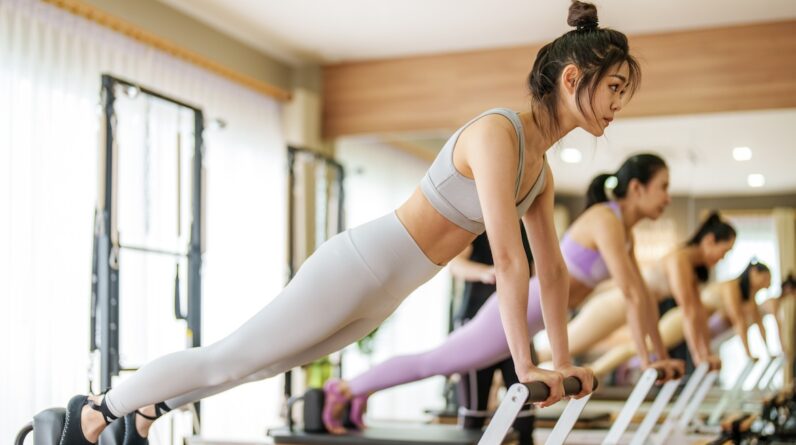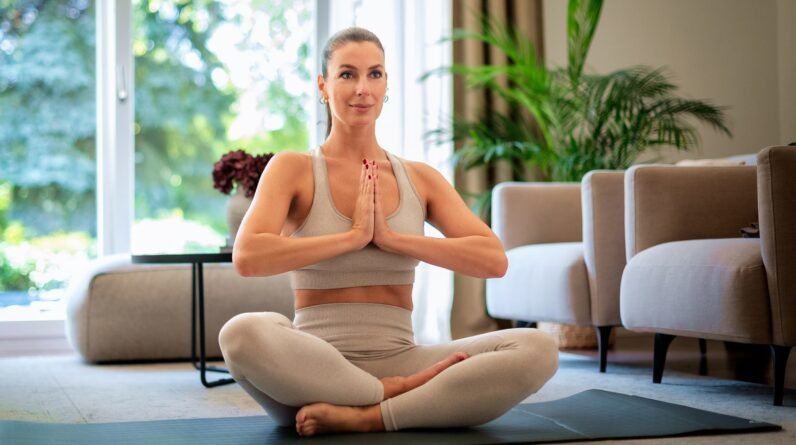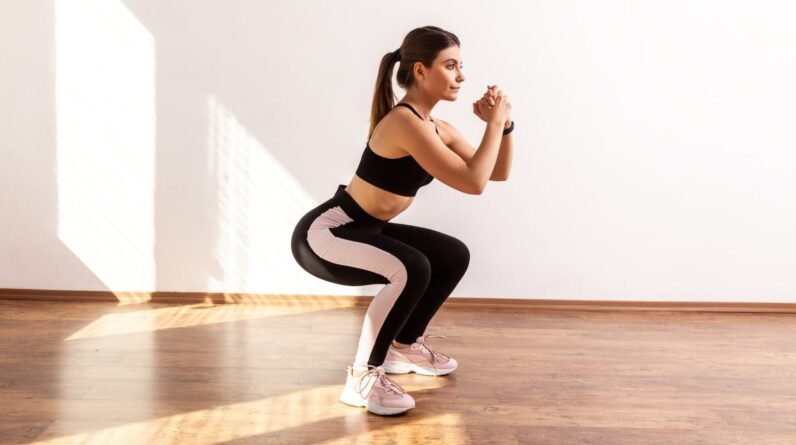
Pilates is a wonderfully versatile workout that anyone can enjoy. That said, you may not know that it can extend far beyond reformer or mat Pilates.
“I firmly believe Pilates can be for anyone and everyone, but it’s important to remember that each person’s body is unique, considering genetic differences and individual preferences,” says Victoria Repa, a certified Pilates instructor and founder of the fitness platform BetterMe.
That’s where different flavors of this workout can come in handy: Variations of Pilates can help you find the workout that best caters to your own personal fitness goals, preferences, or existing injuries.
Here’s what to know about the pros and cons of lesser known types of Pilates—plus, how to tell if they’re right for you.
1. Cadillac Pilates
This form of Pilates makes use of a large, specialized piece of equipment with a bed-like frame. It has springs, bars, and straps to allow for a wide range of exercises, from gentle stretches to more advanced Pilates movements. The push-through bar and trapeze challenge core stability and help with stretching.
“Cadillac Pilates helps to improve flexibility and muscle tone by targeting specific areas,” Repa says. “It’s often used not only to maintain physical fitness, but also for rehabilitation, since it can isolate certain muscle groups. This reduces strain on those who are injured.”
In fact, Pilates founder Joseph Pilates called this invention the Cadillac because it had all the bells and whistles a practitioner could want, while still having an air of comfort and luxury, per Studio Pilates. Because of the modifications that can be made on the Cadillac, it’s a fantastic choice for those who are pregnant, injured, or older.
That said, Cadillac Pilates involves specialized equipment that’s usually only available in studios—and beginners may find it challenging to learn on their own.
“This piece of equipment has a high therapeutic value for rehabilitation clients, but is generally only used in private sessions,” says Carissa Fernandez, a Balanced Body comprehensively certified Pilates instructor and master trainer at Club Pilates.
2. Chair Pilates
Pilates founder Joseph Pilates designed chair Pilates equipment to be compact for use in your home, Fernandez says.
It can help you target a variety of different areas, no matter what level you’re at in your Pilates practice.
“This form of Pilates focuses on exercises that improve balance, stability, and functional strength, particularly targeting the core and lower body,” Repa says. “The exercises can be adapted to different levels of difficulty, making chair Pilates suitable for both beginners and more advanced practitioners.”
If you don’t have a Pilates chair, some exercises can still be performed on an everyday chair.
“An alternative to using a specialized Pilates chair is performing similar exercises at home with a sturdy, regular chair,” Repa says. “This approach involves a series of low-impact movements while seated or supported, making it an ideal option for seniors with chronic pain or limited mobility.”
Chair Pilates can also be helpful for those who have trouble getting down to the floor—or who can’t stand at all, per the United Kingdom’s National Health Service. Opt for a chair with a flat, firm backrest and seat.
However, the range of exercises in chair Pilates is more limited compared to other Pilates equipment like the reformer or Cadillac, so it may not provide as comprehensive of a full-body workout.
“I firmly believe Pilates can be for anyone and everyone, but it’s important to remember that each person’s body is unique, considering genetic differences and individual preferences.” —Victoria Repa, certified Pilates instructor
3. Barrel Pilates
This practice involves a curved barrel, which allows for deep stretches and increases your range of motion.
“Barrel Pilates is designed to help you feel the articulation of your spine through feedback,” Fernandez says. “It’s a great piece of equipment for beginners.”
The design of the barrel supports your body’s natural curves, which can be especially helpful if you’re looking to improve your posture and overall body alignment.
“Barrel Pilates helps to enhance flexibility, improve spinal alignment, and strengthen the core,” Repa says.
This equipment is also great for working your abs, shoulder blades, internal and external obliques, and muscle groups associated with tight hips, per Birmingham Pilates Studios.
That said, like other forms of Pilates involving specialized equipment, Barrel Pilates is typically only available in dedicated Pilates studios. “Plus, the intensity of some exercises on the barrel may not be suitable for individuals with certain physical limitations or back conditions,” Repa adds.
4. Fletcher Pilates
This Pilates style is helpful if you’re looking to improve your coordination and flow. It encourages you to become more aware of your body and to practice mindfulness throughout your practice.
“Fletcher Pilates is an adaptation of Pilates developed by Ron Fletcher, who was a student of Joseph Pilates himself,” Fernandez says. “This style of Pilates incorporates strength and balance through graceful choreography.”
Although Fletcher Pilates can incorporate specialized equipment—such as a reformer, Cadillac, or chair—it can also be practiced on the mat.
“One of the primary advantages of Fletcher Pilates is its emphasis on the connection between breath and movement, which can deepen the overall experience and effectiveness of the workout,” Repa says. “However, its elements may not appeal to everyone, particularly those who prefer a more structured or traditional approach to fitness.”
It’s also not as widely practiced as many other types of Pilates, which can make it challenging to find qualified instructors.
5. Tower Pilates
The Pilates tower is a vertical frame that provides resistance from different color-coded springs placed on your hands or feet. Because the springs pull you in a different direction than you are trying to move, this equipment requires balance and control.
“These Pilates principles can take a while to feel in your body, so most of these exercises require some knowledge to do them correctly and get the maximum benefit from the workout,” Fernandez says.
The design of the Pilates tower encourages proper alignment, which can help prevent injuries and improve posture, says Repa.
However, there are some drawbacks to consider.
“Access to tower Pilates may be limited, as the equipment is typically found only in specialized studios,” Repa says. “Plus, while the variety of exercises is a strength, the focus on strength training may not appeal to those who prefer the fluidity of other Pilates methods.”
6. Neuropilates
Neuropilates combines traditional Pilates with principles of neurological rehab, focusing on exercises that promote motor control, balance, coordination, and overall functional movement. As with Fletcher Pilates, this Pilates style emphasizes the mind-body connection.
“This method is specifically designed to improve neural connections, making it particularly beneficial for individuals with neurological conditions or injuries,” Repa says.
After three months of practicing neuropilates, adults who had motor disabilities after a stroke experienced better daily functioning, balance, dexterity, and coordination compared to a control group, per a 2024 study in the journal Healthcare. They were also more satisfied with their treatment.
However, neuropilates requires trained instructors who understand both Pilates principles and neurological rehabilitation, which may not be readily available in all areas.
Well+Good articles reference scientific, reliable, recent, robust studies to back up the information we share. You can trust us along your wellness journey.
- García-Bravo C, Delgado-Lobete L, Montes-Montes R, Rodríguez-Pérez MP, Trugeda-Pedrajo N, Fernández-Gómez G, García-Bravo S. Effects of Neuropilates on Functional Outcomes in Chronic Stroke: A Randomized Clinical Trial. Healthcare (Basel). 2024 Apr 17;12(8):850. doi: 10.3390/healthcare12080850. PMID: 38667612; PMCID: PMC11049962.







